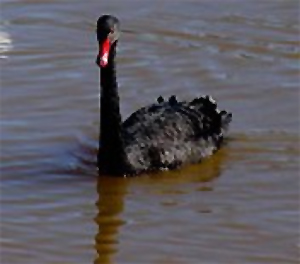
Fukushima Daiichi and the Black Swan
April 11, 2011
As of today, two people were confirmed dead at Fukushima Daiichi, operators who were in the basement of the Unit 4 turbine building attempting to restore electrical power. They were killed by the tsunami, not the earthquake, hydrogen explosions, or radiation. Compare this to the combined total of dead and missing as a result of the March 11 earthquake and the April 7 aftershock (12,985 dead and 14,809 missing, as of April 10), and we are talking about a casualty rate of 0.01% directly associated with the two nuclear stations. The understandable concern about the effects of radiation released by Fukushima Daiichi over the ensuing weeks has been entirely overblown by the media. Anyone born between 1945 and 1980 has inhaled and ingested fallout from atmospheric nuclear tests, the last being conducted by China in October 1980. Thyroid doses from Iodine-131 have been as high as 16 rads in some areas of the western United States from our own nuclear testing. Current estimates of radiation released from Fukushima Daiichi indicate radiation levels between 0.00001 and 0.00007 rads per hour. A whole-body CT scan exposes you to about 72 rads of radiation. The 1979 accident at Three Mile Island was the result of multiple personnel errors involving both the initiating event and the subsequent loss of core cooling and partial meltdown. In the case of TMI-2, an equipment failure was the major cause, but operator training and plant procedures were contributing factors. Chernobyl also resulted from personnel errors in that it was initiated by the plant operators taking direct actions to violate their procedures and placing the reactor in a condition for which it was not designed or analyzed. The accident at Fukushima Daiichi was a Black Swan (2) event, meaning it was unpredictable, had major consequences, and in the end will be rationalized by “experts” as being totally predictable and preventable. It was not caused by man; it was caused by geologic processes that have been going on since the Earth was formed 4.5 billion years ago. A Black Swan event (3), as described by author Nassim Nicholas Taleb, is an event that is an outlier, something that lies beyond the realm of regular expectations. It has an extreme effect on society, and we typically concoct an explanation for it after the fact despite its outlier characteristics. Discovering life in another solar system would be a Black Swan event. The Japanese earthquake and tsunami of March 11, 2011 was another. (The only magnitude 9 earthquake recorded in North America was the Alaskan earthquake on Easter Sunday, 1964. It was rated at 9.2. Those who experienced and survived it would probably agree that it met the definition of a Black Swan event.) What was it about the Tohoku earthquake that made it a Black Swan event for the Fukushima Daiichi nuclear power plant? First, it was a magnitude 9.0 earthquake, which means nothing when discussing the design features of nuclear power plants or buildings and bridges for that matter, but it ranked among the top five since scientists began recording them in 1900. What seismic design tries to determine is how much the ground moves as the earthquake waves pass. Acceleration is typically referenced to gravity, or 32 feet per second squared. Something moving at 1g would be moving at 32 feet per second or about 22 mph. Fukushima Daiichi was designed for accelerations in the neighborhood of 0.44g to 0.49g. The ground movement from the Tohoku earthquake was between 0.32g and 0.51g at the plant site, clearly exceeding the station design, but survivable. In the United States, nuclear plants are designed for two types of earthquakes. First is the Operating Basis Earthquake (OBE), which is an earthquake that will allow the plant to continue operating with no damage to structures, systems or components. The station is required to conduct a normal shutdown and inspection following an OBE. The second is the Safe Shutdown Earthquake (SSE). During a quake of this magnitude, some damage may occur and the plant may trip, but all structures, systems, and components needed to maintain the reactor core in a safe, stable condition must remain functional. At Fukushima Daiichi, ground acceleration exceeded the SSE basis; however, the units were safely shut down and reactor cooling was maintained by safety-related systems powered from the emergency diesel generators. This condition lasted approximately 55 minutes. The earthquake-generated tsunami was the follow-up punch that floored Fukushima Daiichi. The plant was designed to withstand a 19-foot wave. The wave that hit on March 11 was 49 feet high, 39 feet above ground level. It flooded the emergency diesel generators and washed away their fuel oil tanks. It flooded electrical switchgear that was supplying power to the core cooling systems. It flooded the motors for vital pumps and valves. And it killed two workers. Fukushima Daiichi could have survived the tsunami. The tsunami was inevitable. With 20-20 hindsight, “experts” will describe why a 49-foot tidal wave was within the realm of possibilities and why the designers, constructors, owners and operators of Fukushima Daiichi should have expected it. It was a classic Black Swan event; they should have known it was coming. It was clearly predictable. Any fool could see that.
Biography Contact Bob Ciminel: bobciminel@yahoo.com
1 The correct spelling is Fukushima Dai-ichi, which means Fukushima Number 1. Fukushima Dai-ni or Fukushima Number 2 is a sister plant seven miles south of Fukushima Dai-ichi. 2 Prior to 1647, no one had ever seen a black swan, and the term “a black swan” meant something unbelievable or a falsification. The term was originally used by the Roman poet Juvenal in the 1st Century AD. 3 The Black Swan: Second Edition: The Impact of the Highly Improbable
Publish A Letter in SitNews Read Letters/Opinions
|
|||
